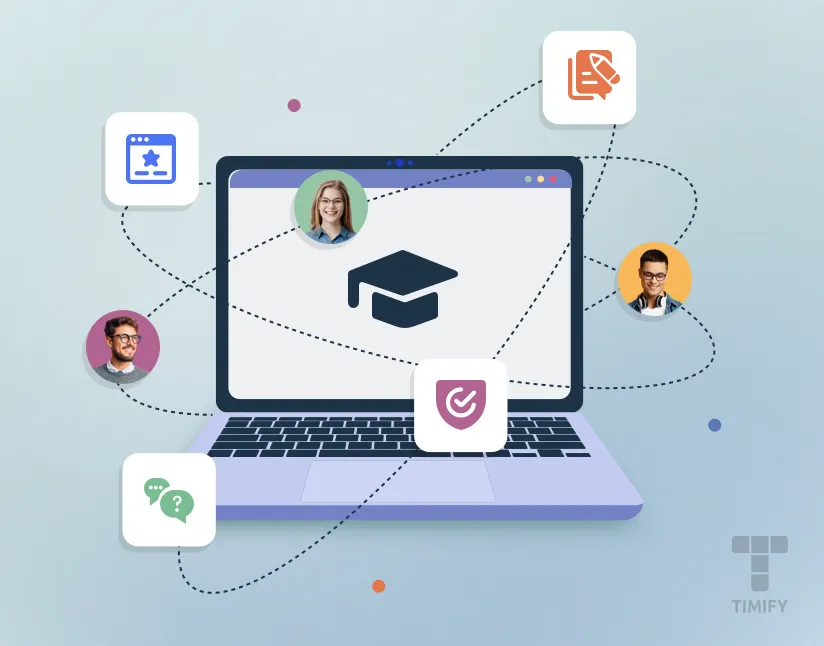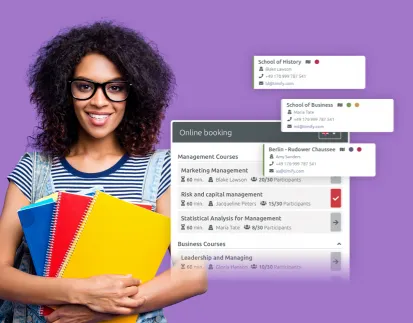
Building a course-centered community can help students interact, discuss their experiences, and pose queries. Such an environment fosters a sense of belonging and engagement among students. This also allows you to gain a loyal student base that supports your course and acts as its advocate and ambassador.
Moreover, an engaged community provides ongoing feedback that can assist you in refining your courses to meet your student's needs and requirements better.
Another advantage of having an online community is you can maintain contact with your students even after they have completed your courses. This fosters long-term interest and recommendations.
In this post, you’ll learn various methods and tips to build a community online for your course, which will help boost student loyalty.
1. Define your community purpose and goals
A defined purpose makes it easier for a virtual community to better organize its members' efforts and activities. Whether the community objectives are for work, social life, or personal growth, clear goals give students direction and incentive to participate.
In addition, well-defined objectives make it easier to measure the group's performance and impact, allowing it to continue developing and growing.
Therefore, begin by conducting research to determine the specific objectives of the course community. You should consider the needs, problems, and passions of the students.
For example, here is a list of the various goals and objectives of a web development community.

Your online course community would need such clearly defined goals and objectives.
Survey and interview your students for valuable insight into their preferences and expectations.
In addition, analyzing previous course evaluations or student feedback can help identify areas where students require discussion and engagement space.
You may also obtain influential data via focus groups, popular community topics, or by studying field trends.
Here is an example from the community of Coursera. These conversations about common student ambitions or interests inquiries can help you generate meaningful objectives build a community online with meaningful objectives for a specific community associated to a course.

You may then use this data to compare and contrast different groups of students and reveal shared characteristics. As a result, you can will develop student personas to align community objectives with the unique students' level, learning style, expectations, and aspirations.
This way, you will build a more personalized and efficient community, increasing student loyalty. Furthermore, student personas help build a strong student-focused community that promotes learning, participation, and achievement for everyone.
Finally, involving students in the decision-making and goal-setting processes is crucial. Ask for their opinion using polls, focus groups, or emails where students can express their thoughts and preferences.
This allows for a broader spectrum of viewpoints, ensuring the objectives are meaningful and suitable for all members. Furthermore, when students have a say in the goals, they are more likely to be motivated and engaged in attaining them, resulting in a greater success rate for the group.
2. Select the right platform
Selecting a digital platform that supports your community's goals is crucial.
The online platform you select will determine the features and user experience your students will have. When making this decision, consider the size and demands of your community as well as customization, scalability, and integration options.
Look for features such as user profiles, private messaging, content-sharing capabilities, and analytics.
Having these elements in the platform used by your student community course, community can encourage participation, improve the overall experience, and cultivate a sense of friendship among students.
Lastly, verify safety measures. Ensure the system has solid security features to protect user data and stop hackers. Look for features like encryption, user authentication, and permission settings.
Explore the online community platforms available in the market to find the perfect fit for your ideal community. Some options include social media platforms, community forums, and specialist community management tools.
In Slack, for example, you may create different “channels” for specific conversations.

Meanwhile, the Circle platform lets users create channels, but unlike Slack, it provides paid membership features. In other words, when students join a community built on Circle, they may find free and paid channels.
So, if you think you’ll be providing premium content for paid users, Circle may will be a better option than Slack.
3. Create guidelines and rules
Rules and regulations are necessary when building an online community. They keep the community friendly and safe. They aid in establishing a clear set of expectations and boundaries, ensuring all parties know how to engage with one another.
These rules also create a welcoming environment where everyone feels comfortable sharing their thoughts and views without fear of retaliation.
However, creating community guidelines and regulations requires careful consideration. Establishing a balance between promoting free speech and maintaining a respectful and inclusive environment is essential.
These rules should address aspects such as behavior, content, and moderation to create a secure online space for interaction. You must include restrictions on hate speech, harassment, and disinformation.
If you want to join the Thinkific Studio for Online Course Creators group on Facebook, for instance, you will receive the following rules and guidelines.

Lastly, it is essential to evaluate and update the guidelines consistently. This helps you adapt to the changing dynamics of the community and effectively address any emergent issues.
4. Provide valuable and engaging content
Creating quality content for an online community makes the community more valuable to the members. It also helps you establish credibility and authority within your virtual space. This encourages in-depth participation and debate within the community, strengthening relationships and increasing loyalty.
This also inspires people to participate in conversations, provide their perspectives, and share their expertise with the entire community. The end result is a lively and active platform where users feel appreciated and inspired to make ongoing contributions.
Multimedia elements such as videos, images, and infographics can be an excellent starting point. These elements create a dynamic and captivating experience for your community, increasing their interest and willingness to share your community educational content.
A video, for example, may bring a story to life, enabling your students to engage on a deeper level with your community. Similarly, employing images and infographics may simplify complex ideas.
Sharing your written resources, such as blogs, research, and case studies, is also an effective way to educate your students and build a stronger connection with them.
When sharing, convey only the most critical information and exciting points. Using generative AI to summarize your articles can be valuable in aligning your content with your community's specific needs.
In addition, you may feature guest experts and influencers. Offering members access to exclusive content like e-books, webinars, and tutorials is another great way to make them feel appreciated and maintain their participation. The key is to create content that speaks directly to your demographic and inspires them to participate.
Here's an example of an online community that provides webinars to its members.

Encouraging user-generated content is also a good idea. You may get genuine and engaging content by letting consumers express their thoughts, feelings, and ideas. This is essential because community members should not just learn from you. They should also be able to learn from one another.
5. Actively engage with community members
When people feel like they belong somewhere, they are more inclined to become involved and give back. They will invest their time, energy, and resources to make a positive impact and improve the overall well-being of the community.
One way to build these relationships is to demonstrate genuine interest in engaging with community members. As such, it's crucial to interact with your students through comments, discussions, and social media to build trust and rapport.
In addition, it is possible to arrange regular community events or activities tailored to your students' diverse interests and requirements. These events can include educational projects, skill-sharing sessions, and volunteer opportunities.
Obtaining feedback and input on significant issues or decisions is another effective method for involving your students. Creating opportunities for open communication and actively listening to their viewpoints can demonstrate that their opinions and voices are valued.
Overall, these activities give students opportunities to come together, bond through a shared experience, and progress toward a common objective. The more involved and invested people feel in the community, the stronger the community gets.
6. Recognize and reward members
When people in a community get recognized for their contributions, it gives them a feeling of accomplishment and motivates them to keep contributing. In addition, incentives send a powerful message of recognition and inspire a culture of active participation and community engagement.
There are several approaches to showing appreciation to community members for their efforts. Recognition in public through newsletters, social media, or community events is an effective way. In addition to honoring their contribution, this will motivate others to join in and make a difference.
Sending personalized thank-you notes or emails can also make members feel valued and appreciated.
Another effective way to recognize exceptional contributions or milestones is by regularly giving personalized gifts. This type of recognition can motivate individuals to continue their good work and increase their sense of belonging to the community.
These tangible symbols of appreciation inspire the recipient to keep making a difference by reminding them of the significance of their efforts.
In closing
Investing time and effort into building and nurturing a social community can yield long-term rewards and contribute to the success of individuals and businesses alike.
Implementing the strategies discussed in this article can help you build an online community that keeps customers returning for more.
So, define your community's purpose and goals and communicate them clearly to your students. This will ensure everyone is on the same page and working towards a common objective.
Then, select the right community management platform and create guidelines and rules for your online community. This will provide structure and maintain a positive and respectful online co-working space for all members.
Additionally, regularly engage with your community by responding to comments, addressing concerns, and providing valuable content. Also, recognize and reward members.
Lastly, continuously evaluate and adapt your strategies based on feedback and analytics to ensure your online community remains dynamic and effective.
Ultimately, a thriving community can drive organic growth, attract new customers, and enhance overall success in the digital landscape.

About the author
Baidhurya Mani
Baidhurya Mani is the founder of SellCoursesOnline.com. He regularly shares tips, tools, and strategies to help creators and entrepreneurs build a successful online course business.
Related articles



